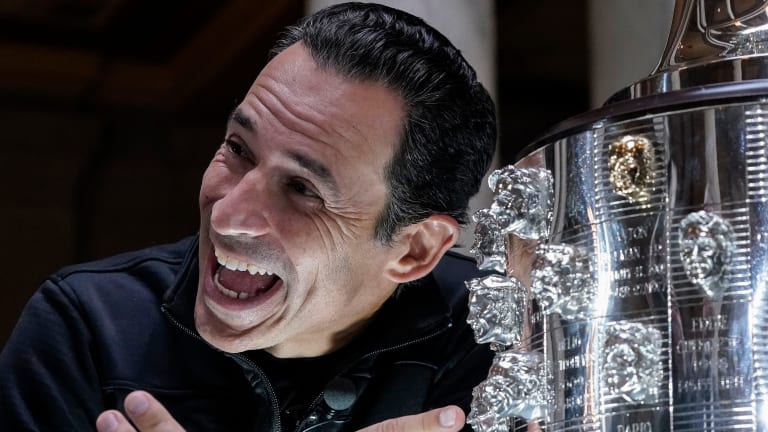
Welcome to the month of May in Indy, where drama is always the watchword

The prelims have been riveting -- four races, four different winners, a spicy rivalry between Scott McLaughlin and Romain Grosjean, and the early signs of a revival by Andretti Autosport.
But we’ve now reached the tastiest part of the NTT IndyCar Series schedule, the hallowed pavement of Indianapolis Motor Speedway for a month of racing that may produce clarity over what we’ve seen so far.
Or it may not, given the parity that makes IndyCar the most competitive major series.
McLaughlin and Grosjean go to Indy having bumped and nudged each other into the best mano-y-mano clash of the early season. McLaughlin, Marcus Ericsson and rookie Kyle Kirkwood have won on the road/street courses so far, while Josef Newgarden’s victory on the oval at Texas gives Team Penske hope that its Indy 500 program is back after three tough years.
Grosjean and Pato O’Ward are the tough-luck guys so far, each with two second-place finishes that left them both agonizing over what could have, should have, happened.
Ericsson’s consistency put him atop the series standings, with four top-10 finishes, including victory at St. Petersburg after O’Ward’s engine hiccupped three laps from the finish. They all could be major stories at Indy.
And the biggest of kahunas, Chip Ganassi Racing and Team Penske, have been joined by Andretti Autosport and Team McLaren as the top teams in the series. They all could, and should, be the heavyweights this month.
So, bring on the GMR Grand Prix on the IMS road course on Saturday, then the never-lift anxiety of 240 mph trap speeds on the oval as teams begin practice next week for the 107th Running of the Indianapolis 500 on May 28.
Who’s going to win? Let me get back to you on that.
The GMR Grand Prix can be an anything-can-happen race, especially if wet weather is involved like last year, when Colton Herta was among the few who kept his car pointing forward and won amid on-and-off rain.
There’s rain in the forecast this weekend, so enjoy the show.
As for the 500, let me get back to you on that, too.
Until a lap is turned on the oval when practice begins Tuesday, I’ll go with anyone with the Ganassi team.
Ganassi cars led 163 of 200 laps last year, when Marcus Ericsson powered into the lead late in the race and beat O’Ward in a two-lap shootout after a red flag.
Ganassi has a four-car powerhouse this year with former 500 winners Scott Dixon, Ericsson and two-time winner Takuma Sato (who is driving only on the five oval tracks this season), along with former series champion Alex Palou.
Also, speaking about Sato, he is bidding to win a third 500, while Helio Castroneves is going for a record fifth 500 victory.
Getting back to Ganassi, it’ll be only the second time since 1990 that a team will field three former 500 winners in the race (Team Penske had Helio Castroneves, Will Power and Simon Pagenaud in 2020 and Rick Mears, Emerson Fittipaldi and Danny Sullivan in 1990). If one of Ganassi’s three former winners doesn’t qualify, that might be the story of the month.
But before we go too far down the track, pay close attention to the practice days next week.
Teams work mostly on race setup the first three days, getting cars to handle in traffic, and shift to simulated qualifying runs on Fast Friday when they’re allowed to crank up turbo boost.
Don’t be fooled by practice speeds that may not accurately reflect who has the strongest cars. The fastest on a particular practice day may have gotten a big aerodynamic tow from cars ahead, while the truly strongest cars on track may be the ones who handle best in traffic but may finish several positions down in the overall order.
Keep an eye on who’s able to pass and who can’t while running in a large pack of cars, because that may reflect who does and doesn’t have the best cars in race conditions.
In recent years, anyone running beyond fourth or fifth in a line of cars has struggled to make a pass because of turbulence. This year IndyCar will allow teams to use aero pieces on the underside of the cars, a setup similar to what was available last month that stabilized cars on the high-speed Texas oval, where the racing was fantastic and drivers were able to climb from deeper in the field.
When the boost is turned up for the Fast Friday practice and next weekend's two qualifying days, the only true indication of a car’s strength is its no-tow speed – the speed when running alone.
Even then, getting a true no-tow speed for four laps in practice can be a struggle because of traffic, especially this year with 34 entries.
Speaking of 34, one car will be bumped this year. And while many may see the 11th-hour entry of R.C. Enerson with Abel Motorsports as the most likely to miss the race, don’t be surprised if the drama runs deeper.
There’s always some kind of drama at Indy.
Even though Enerson won’t run his first practice laps until Tuesday (all other teams took part in the open test April 20), he believes he’s better prepared than in 2021 when his small-budget Top Gun Racing entry was bumped.
Plus, there’s usually a team or two that finds itself thrashing for speed after having missed its setup or suffered a setback that cost them practice time.
That’s the nature of Indy.
It can be as predictable as a warm day in May. But stormy moments are never far away.